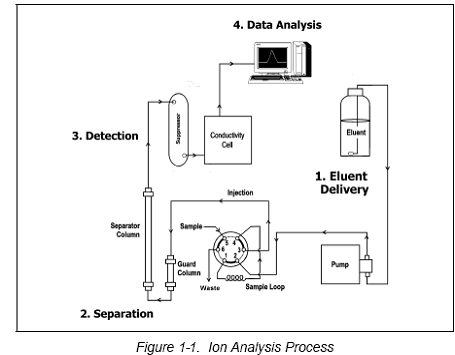Introduction to Ion Chromatography (IC)
The Dionex ICS-90 Ion Chromatography System (ICS-90) performs isocratic analyses using suppressed conductivity detection. An ion chromatography system typically consists of a liquid eluent, a high-pressure pump, a sample injector,separator column, a chemical suppressor, and a conductivity cell. Before running a sample, the ICS-90 is calibrated using a standard solution. By comparing the data obtained from a sample to that obtained from the standard, sample ions be identified and quantitated. A computer running chromatography software automatically converts each peak in a chromatogram to a sample concentration and produces a tabulated printout of the results.

The IC analysis consists of four stages (see Figure 1-1):
1. Eluent Delivery
• Eluent, a liquid that helps to separate the sample ions, carries the sample through the ion chromatography system. The ICS-90 is an isocratic delivery system. This means that the eluent composition concentration remain constant throughout the run.
• Liquid sample is injected into the eluent stream either manually automatically (if an automated sampler is installed).
• The pump forces the eluent and sample through a separator columnchemically-inert tube packed with a polymeric resin).
2. Separation
• As the eluent and sample are pumped through the separator column,the sample ions are separated. In the ICS-90, the mode of separation is called ion exchange and it is based on the premise that different sample ions migrate through the IC column at different rates, depending upon their interactions with the ion exchange sites.
3. Detection
• After the eluent and sample ions leave the column, they flow through a suppressor that selectively enhances detection of the sample ions while suppressing the conductivity of the eluent.
• A conductivity cell monitors and measures the electrical conductance of the sample ions as they emerge from the suppressor and produces a signal based on a chemical or physical property of the analyte.
4. Data Analysis
• The conductivity cell transmits the signal to a computer running chromatography software.
• The chromatography software analyzes the data by comparing the sample peaks in a chromatogram to those produced from a standar solution. The software identifies the ions based on retention time, and quantifies each analyte by integrating the peak area or peak height. The results are displayed as a chromatogram, with the concentrations of ionic analytes automatically determined and tabulated.

Overview of the ICS-90
In all major respects, the ICS-90 operating process is similar to the overview ofion analysis described in Section 1.1.
The ICS-90 is an integrated ion chromatography system containing a pump, aninjection valve, and a conductivity cell. Other system components, including a guard column, separator column, and suppressor, must be ordered separately.These components vary, depending on the analyses to be performed. System components are described and illustrated in Section 2.1.3.
ICS-90 operation is controlled remotely by a PC (personal computer) running Microsoft® Windows® XP or Windows® 2000 operating system and either the Chromeleon® Chromatography Management System or Chromeleon Xpress chromatography software. Chromeleon provides all of the system control features found in Chromeleon Xpress, plus complete data acquisition and data processing functions.
For communication between the ICS-90 and the PC on which Chromeleon or
Chromeleon Xpress is installed, the ICS-90 must be connected to a USB
(Universal Serial Bus) port on the PC or a USB hub. For installation instructions, see Appendix B of this manual.
Product Versions
A newer version of the ICS-90, called the ICS-90A, has a feature that allows the approximate flow rate to be displayed in Chromeleon or Chromeleon Xpress (see Section B.15). Unless otherwise specified, all of the information in this manual applies to both the ICS-90 and the ICS-90A. If you are unsure which system you have, check the model data label on the rear panel.
|